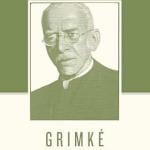“Once I began to read about the saints, I was greatly surprised to discover how real and human they were. They were not perfect people, and they were poignantly aware of that. But each one of the saints had a deep desire to enter into an intimate relationship with God and purge themselves of their character flaws to embrace God’s will rather than their own. Their humility made the saints quite approachable to me.” — Elizabeth Ficocelli, author
In her new book Therese, Faustina, and Bernadette: Three Saints Who Challenged My Faith, Gave Me Hope, and Taught Me How to Love, author Elizabeth Ficocelli tells the story of how she befriended three woman saints in the Catholic tradition, and how they transformed her life by teaching her the meaning of authentic femininity. We invited Ficocelli to tell us a bit more about her faith journey and how she became intimately acquainted with these three remarkable saints from the past.
 Your story is not only about three Catholic saints you came to love as friends, but about your conversion from Protestantism to Catholicism. How did you decide to become a Catholic?
Your story is not only about three Catholic saints you came to love as friends, but about your conversion from Protestantism to Catholicism. How did you decide to become a Catholic?
Since childhood, I have felt a calling to mission, although I did not understand initially what that mission entailed. All I knew is that I was created for a purpose specifically designed by God. From a young age, I was intrigued with the limited glimpses of Catholicism I received through friends, a local convent, and entertainment such as The Sound of Music and “The Flying Nun.” God would really grab my attention, however, during my college years when he introduced me to my future husband, a cradle Catholic. It was on campus that I experienced my first Catholic Mass and had a powerful Emmaus moment of recognizing God’s presence in the Eucharist. My decision to formally enter the Catholic Church in my early 20’s was based on my desire to share a common faith with my husband, to raise our future children in the same faith, and to experience God in an intimate way in the worship.
You say in your book that surprisingly, it was within the Catholic faith that is often labeled as male-dominated, archaic and insensitive to the plight of women, that you found the key to authentic femininity. What do you mean by that?
In my early professional life, I struggled to compete in a man’s world by looking and acting like my male co-workers. The self-denial of my true identity ultimately left me feeling empty and disillusioned. It was through the brilliant writings of Pope Saint John Paul II — in particular, his encyclical, Mulieris Dignitatum (On the Dignity and Vocation of Women); his apostolic Letter to Women; and most impressively, the Theology of the Body, that I discovered my true role as woman in God’s perfect design. I learned that as women we are equal in value, worth, and dignity because we too are created in the image and likeness of God. I also came to understand and appreciate my gender’s unique attributes, perspectives, qualities, and influence we have in our relationships as we employ the virtue of love. The Catholic Church through her wise teachings and leadership has enabled me to embrace myself as someone who is precious and worth dying for – a concept not professed in the modern culture, and one that is quite liberating!
As a Protestant, I’m less aware of the centrality and power the Saints can have on a life of faith. What is it about the saints that is so significant for Catholics?
As eternal beings, souls on earth, in purgatory, and those blessed to be in heaven are bonded in a spiritual solidarity we refer to as the Communion of Saints. We form a spiritual family that shares love and prayers for one another, even when death separates us physically. The term “saints” refers to those individuals whom the Church has officially recognized as having demonstrated heroic virtue on earth and miraculous intervention after death. They are men, women, and even children upheld as models for the rest of us, as we are all called to be saints. Because of their near proximity to God, the saints can intercede on our behalf with prayers that are far more powerful than our own. They teach us by how they lived their lives, they relate to our struggles, and they desire to help us attain salvation. This is why they are so highly revered (but not worshipped – worship is reserved for God alone).
What surprised you most about the saints, as you began to explore them as a new Catholic?
Prior to becoming Catholic, I never gave much thought to the saints. As a new Catholic, I wasn’t immediately drawn to learning about them because I presumed them to be perfect and pious people who did nothing but sit in a church and pray all day. Once I began to read about the saints, however, I was greatly surprised to discover how real and human they were. They were not perfect people, and they were poignantly aware of that. Some had even led scandalous lives prior to their conversion of heart. But each one of the saints had a deep desire to enter into an intimate relationship with God and purge themselves of their character flaws to embrace God’s will rather than their own. Their humility made the saints quite approachable to me.
How did you discover the three saints you reflect on in your book? What was your first experience with each one like?
I met Therese first, in the form of a religious medal I found as a child. However, I would not realize who the woman on the medal was until 15 years later when I had become Catholic and started reading about the saints. When I read Therese’s autobiography, Story of a Soul, I fell in love with her. For me, Therese was like a guardian angel who gently led me into the Catholic Church and who would take her place at the heart of my mission as author, speaker, and evangelist.
I met Faustina in the 1990’s when I read her diary, Divine Mercy in My Soul. Like Therese, I found Faustina simple, obedient, and deeply in love with Christ. In a powerful Confession miracle shortly after reading her diary, I experienced a tangible sensation of being washed clean, just as Faustina described Jesus telling her in a vision: “I wish to pour out my ocean of mercy upon all sinners…” As I’ve shared this experience in speaking and writing, it has inspired many people to return to the healing Sacrament of Confession.
My third saint companion, Bernadette, came into my life in 2006 when I was sent to Lourdes, France, to write a book to commemorate the 150th anniversary of these famous apparitions. It was through careful research from credible sources and the reading a small notebook of this saint’s writings that I came to know the real Bernadette – not a whimsical child as some movies or novels have portrayed her – but as a woman of serious faith and mission.
You refer to these saints as ‘friends.’ Given that they’re no longer living, what’s the nature of these friendships?
It’s a tremendous comfort for me to know that these three spiritual giants – Therese, Faustina, and Bernadette – reside in heaven and are interested in my small life on earth. I can read about their spiritual lights and mystical experiences to uncover great truths of following Jesus and living the Gospel. But I can also call upon these saints in my prayers and ask them to shed light on challenges I encounter daily as wife and mother and disciple. I know these spiritual girlfriends will hear me and respond. They have helped me see that I am not alone on my journey. And one day, God willing, I will meet my saintly companions face to face.
What ultimately, did these three saints, teach you about Catholic womanhood?
My saintly friends have taught me a great deal about what it means to be a virtuous woman. While all three of them demonstrated a host of heroic virtues in their own lives, each exemplifies to me a particular virtue that I have applied in my own spiritual walk.
For Bernadette, that virtue is faith. She demonstrated a steadfastness of faith in standing up for her visions, despite threats by police, hostile clergy, and disbelieving neighbors. She did not just proclaim the messages she received from the Virgin in the grotto; she lived the messages of prayer, penance, and conversion meant for all of us. Bernadette encourages me to remain faithful in adversity and to put my faith into action by being cognizant of and compassionate toward those who are suffering around me – physically, materially, and spiritually.
For Faustina, the virtue is hope. She lived in a dark time – Poland, just prior to the Nazi invasion – when it would have been easy to give into despair. Yet she clung to the visions and messages she received from Jesus about his Divine Mercy and held great hope that this mercy was the answer for mankind and the future. Faustina reminds me to trust God in everything, not to give into the negative around me, and to continually turn my life over to God, even when it hurts and is scary.
For Therese, the virtue is love. She has taught me how to see God as a loving and merciful father, and how I don’t have to achieve great things in order to win his love. Rather, I am to be little, humble, and obedient, as she was. Therese also has shown me what it really means to love those God has put in my life, even and especially when they can be difficult to love.
Who do you hope reads your book and what do you most hope they’ll take away from it?
My publisher (Ave Maria Press) specifically requested that I write this book for women. But the truth is, we are all on a spiritual journey and we can all benefit from spiritual friendship. Males in the media who have interviewed me about this book have told me they gained a lot from reading it. The book is not intended to teach theology of Catholicism, but rather to share some very personal discoveries I’ve made during my faith walk and some great resources I found along the way. People of all faiths are welcome to read it. My hope is that those who do will find it helpful and inspiring — to see faith as much more than a personal, isolated experience, but a communion of hearts and minds — as they seek to find God and live out the mission he has particularly prepared for them.
Read an excerpt from Therese, Faustina, and Bernadette at the Patheos Book Club here.














